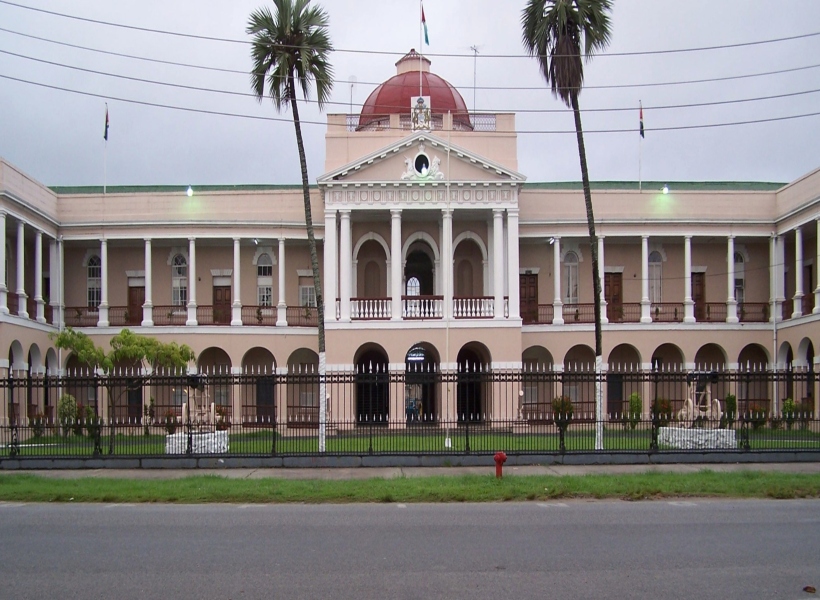By Joel Bhagwandin, MSc.
The political opposition (APNU/AFC) recently outlined its alternative development plan for the country should it win the next general elections in 2025. This article is dedicated towards critically evaluating those proposed plans within a pragmatically implementable framework aimed at testing the economic and financial robustness of the proposed alternative development agenda.
With the absence of the actual policies that the party intends to pursue to achieve the abovementioned goals, it is useful at this stage to interrogate the viability of the party’s alternative policies―within a sustainable framework.
Proposal # 1. The party stated that it will measure progress by… “how high people’s quality of life is and how satisfied they feel…“The ultimate objective of the party will be to guarantee a livable income for all households, regardless of size, composition, economic circumstance, or location… by well-designed policies such as job creation, living wages, wealth creation such as small business development, and a comprehensive social protection system that includes family support and child care, adequate pensions and elderly care, subsidies and waivers, such as mortgages, rents and utilities, and the guaranteeing of food and nutrition security…realizable in a matter of few years”. In a subsequent statement, the opposition reportedly pegged a “livable wage” at G$150,000 monthly.
The question is, how does it intend to achieve this for both the public and private sectors considering that salaries and wages are determined by several factors. In the private sector for instance, salaries and wages are determined increasingly by(a) market forces, whereby firms are competing for the top tier skills, (b) performance metrics, (c) competencies, experience, and qualification, and (d) based on the sum firms could afford to pay relative to their annual turnover. For context, as of the end of 2022, GDP per capita income (overall GDP) was recorded at US$17,500, which translates to an average monthly income of US$1,458 or G$304,791. Using this same metric, but with non-oil GDP as the numerator, in that way excluding the oil economy’s contribution to overall GDP, the adjusted per capita income is US$6,250, which would translate to US$521 monthly or G$108,855. The minimum wage for the public sector is G$75,000.
According to Guyana’s Labour Force Survey (GLFS) for Q3 of 2021, the total public sector labour force was 57,551 persons accounting for 23% of the total employed labour force, which represented a record low labour force participation rate of 49.6% for that period.
Let’s assume, for the sake of this discussion, that the public sector employees are now an estimated 60,000, and 10% of that number are earning the minimum wage of $75,000. It would cost the treasury an additional $5.4 billion annually to adjust this segment of wages upward to the proposed minimum benchmark of G$150,000. However, let’s now examine this in the broader sustainable framework coupled with what the incumbent Government has actually done, and continues to do in this regard. To this end, citing budget 2023, the total allocation for employment cost is an estimated G$105.7 billion, representing a cumulative increase of 47% from FY 2020 position of G$71.8 billion, and a year-over-year (YoY) increase of G$15.8 billion or 17.5% compared to FY 2022. This amount represents 27% of the total (estimated) current expenditure for FY 2023 and 33% of the estimated non-oil revenues for the Government.
With that in mind, the increased allocation in FY 2023 towards employment cost of nearly $16 billion are to: (1) provide for the salary adjustments or correction of anomalies across comparative levels in the public sector; (2) provide for other forms of allowances or concessions for certain segments of workers, (the President, His Excellency Dr. Mohamed Irfaan Ali, recently announced some of the upward adjustments in these respects); (3) to cater for across the board increases, which will be announced at a later date, and (4) new recruits.
Altogether, the [incumbent] government has undertaken a number of measures aimed at improving wages and salaries in the public sector, albeit within a sustainable and prudential framework. Further, it is important to note that it would not be sustainable to utilize the funds from the Natural Resources Fund (NRF) to finance current expenditure to a large extent. Rather, the spending of the NRF is prescribed in the NRF Act, which is to finance the development agenda―that is, the capital expenditure side of the budget. These allocations are to finance largely the crucial investments needed to diversify the economy over the longer term.
Notably, the current expenditure represents 123%of the Government’s non-oil revenues. This means that almost 19% of current expenditure is already financed from the oil revenues (NRF). And, of the total current expenditure, employment cost accounts for 33% of the non-oil tax revenue, debt service accounts for another 12.5% and 45.5% of the current expenditure accounts for the day-to-day administrative expenses for the public sector institutions.
Therefore, any further increases in the current expenditure that would have to be financed from the oil revenues would not be sustainable over the long term. Imperatively, this is where fiscal discipline is paramount in order to ensure that a strong and stable macroeconomic environment prevails, thus reinforcing the economy’s resilience to external shocks emanating from the global economy and other exogenous and endogenous factors.
Proposal # 2. “The APNU/AFC proposes to maximize revenues from oil resources and negotiate better fiscal terms for the PSA”._ The [incumbent] Government has already sought to maximize the in-country value from the oil resources through the implementation of the Local Content Act and the gas-to-energy (GTE) project. Together, these will generate an estimated US$2 billion in additional benefits, both directly and indirectly annually, that will increase relative to the increased pace and scaling up of oil production in future years. The [incumbent] Government has also developed a new PSA model with significantly improved fiscal terms such as the introduction of a 10% corporate tax, royalty rate of 10% and cost recovery ceiling down from 75% to 65%, with the 50/50 profit split remaining.
Finally, Proposal #3. The Opposition proposes to “expand the non-oil economy and reduce wastage in public procurement by some $200 billion annually”.
Concluding Remarks
Questions for the APNU/AFC/Opposition. Considering all of the foregoing:
i) What will the Opposition do differently, and how will it achieve its objectives in terms of a livable wage for both the public and private sectors? What are the policies it will implement? In the case of the private sector, for example, imposing a minimum wage threshold in an abstract manner that smaller firms may not be able to sustain could have adverse effects, such as, forcing those firms to reduce the size of their workforce, which would push up the rate of unemployment.
ii) How will they maximize revenues from the oil and gas sector and what are some of the alternative fiscal terms it will seek to implement? Bearing in mind that in phasing out the development, the risk of ultimately having stranded resources in the long run becomes higher, at the expense of short term and short-lived gains. How would they balance this risk? More so, taking into account that the exploration activities pursuant to the 2016 PSA expires in 2027, and so far, only 1.45% of the entire Stabroek Block has been explored to date (inclusive of the 46 discoveries). This means that by 2035-2038, in another 12-15 years from now, it is likely that all of the capital investment (exploration + development costs) will have been recovered by then, thereby increasing Guyana’s profit share up from 12.5% to about 25%, all other things being equal.
iii) What do they propose to do differently to expand the non-oil economy, especially since their economic philosophy hinges on increased spending on the current expenditure side of the national budget versus capital expenditure, which is not sustainable in the long-term.
iv) How will they save $200 billion annually from procurement wastage when the evidence is overwhelmingly to the contrary during their tenure in government previously, as per the Auditor General’s audit reports?
About the author
Joel Bhagwandin, MSc is the Director of Financial Advisory, Market Intelligence, and Analytics at SphereX Professional Services Inc. He can be reached at [[email protected]](mailto:[email protected] “”).









